+ データを開く
データを開く
- 基本情報
基本情報
| 登録情報 | データベース: PDB / ID: 9jvh | |||||||||||||||||||||
|---|---|---|---|---|---|---|---|---|---|---|---|---|---|---|---|---|---|---|---|---|---|---|
| タイトル | Cryo-EM structure of the mmGPR4-Gs receptor in pH6.2 | |||||||||||||||||||||
 要素 要素 | G-protein coupled receptor 4 | |||||||||||||||||||||
 キーワード キーワード | MEMBRANE PROTEIN / pH6.2 / mmGPR4 / Gs | |||||||||||||||||||||
| 機能・相同性 |  機能・相同性情報 機能・相同性情報Class A/1 (Rhodopsin-like receptors) / G alpha (q) signalling events / glomerular mesangial cell development / regulation of vascular permeability / response to acidic pH / cellular response to acidic pH / angiogenesis involved in wound healing / positive regulation of Rho protein signal transduction / regulation of cell adhesion / negative regulation of angiogenesis ...Class A/1 (Rhodopsin-like receptors) / G alpha (q) signalling events / glomerular mesangial cell development / regulation of vascular permeability / response to acidic pH / cellular response to acidic pH / angiogenesis involved in wound healing / positive regulation of Rho protein signal transduction / regulation of cell adhesion / negative regulation of angiogenesis / G protein-coupled receptor activity / adenylate cyclase-activating G protein-coupled receptor signaling pathway / positive regulation of inflammatory response / phospholipase C-activating G protein-coupled receptor signaling pathway / G protein-coupled receptor signaling pathway / plasma membrane 類似検索 - 分子機能 | |||||||||||||||||||||
| 生物種 |  | |||||||||||||||||||||
| 手法 | 電子顕微鏡法 / 単粒子再構成法 / クライオ電子顕微鏡法 / 解像度: 2.76 Å | |||||||||||||||||||||
 データ登録者 データ登録者 | Wen, X. / Rong, N.K. / Yang, F. / Sun, J.P. | |||||||||||||||||||||
| 資金援助 |  中国, 1件 中国, 1件
| |||||||||||||||||||||
 引用 引用 |  ジャーナル: Cell / 年: 2025 ジャーナル: Cell / 年: 2025タイトル: Evolutionary study and structural basis of proton sensing by Mus GPR4 and Xenopus GPR4. 著者: Xin Wen / Pan Shang / Haidi Chen / Lulu Guo / Naikang Rong / Xiaoyu Jiang / Xuan Li / Junyan Liu / Gongming Yang / Jiacheng Zhang / Kongkai Zhu / Qingbiao Meng / Xuefei He / Zhihai Wang / ...著者: Xin Wen / Pan Shang / Haidi Chen / Lulu Guo / Naikang Rong / Xiaoyu Jiang / Xuan Li / Junyan Liu / Gongming Yang / Jiacheng Zhang / Kongkai Zhu / Qingbiao Meng / Xuefei He / Zhihai Wang / Zili Liu / Haoran Cheng / Yilin Zheng / Bifei Zhang / Jiaojiao Pang / Zhaoqian Liu / Peng Xiao / Yuguo Chen / Lunxu Liu / Fengming Luo / Xiao Yu / Fan Yi / Pengju Zhang / Fan Yang / Cheng Deng / Jin-Peng Sun /  要旨: Animals have evolved pH-sensing membrane receptors, such as G-protein-coupled receptor 4 (GPR4), to monitor pH changes related to their physiology and generate adaptive reactions. However, the ...Animals have evolved pH-sensing membrane receptors, such as G-protein-coupled receptor 4 (GPR4), to monitor pH changes related to their physiology and generate adaptive reactions. However, the evolutionary trajectory and structural mechanism of proton sensing by GPR4 remain unresolved. Here, we observed a positive correlation between the optimal pH of GPR4 activity and the blood pH range across different species. By solving 7-cryoelectron microscopy (cryo-EM) structures of Xenopus tropicalis GPR4 (xtGPR4) and Mus musculus GPR4 (mmGPR4) under varying pH conditions, we identified that protonation of H and H enabled polar network establishment and tighter association between the extracellular loop 2 (ECL2) and 7 transmembrane (7TM) domain, as well as a conserved propagating path, which are common mechanisms underlying protonation-induced GPR4 activation across different species. Moreover, protonation of distinct extracellular H contributed to the more acidic optimal pH range of xtGPR4. Overall, our study revealed common and distinct mechanisms of proton sensing by GPR4, from a structural, functional, and evolutionary perspective. | |||||||||||||||||||||
| 履歴 |
|
- 構造の表示
構造の表示
| 構造ビューア | 分子:  Molmil Molmil Jmol/JSmol Jmol/JSmol |
|---|
- ダウンロードとリンク
ダウンロードとリンク
- ダウンロード
ダウンロード
| PDBx/mmCIF形式 |  9jvh.cif.gz 9jvh.cif.gz | 63.9 KB | 表示 |  PDBx/mmCIF形式 PDBx/mmCIF形式 |
|---|---|---|---|---|
| PDB形式 |  pdb9jvh.ent.gz pdb9jvh.ent.gz | 43.4 KB | 表示 |  PDB形式 PDB形式 |
| PDBx/mmJSON形式 |  9jvh.json.gz 9jvh.json.gz | ツリー表示 |  PDBx/mmJSON形式 PDBx/mmJSON形式 | |
| その他 |  その他のダウンロード その他のダウンロード |
-検証レポート
| 文書・要旨 |  9jvh_validation.pdf.gz 9jvh_validation.pdf.gz | 356 KB | 表示 |  wwPDB検証レポート wwPDB検証レポート |
|---|---|---|---|---|
| 文書・詳細版 |  9jvh_full_validation.pdf.gz 9jvh_full_validation.pdf.gz | 357.8 KB | 表示 | |
| XML形式データ |  9jvh_validation.xml.gz 9jvh_validation.xml.gz | 7.1 KB | 表示 | |
| CIF形式データ |  9jvh_validation.cif.gz 9jvh_validation.cif.gz | 10.7 KB | 表示 | |
| アーカイブディレクトリ |  https://data.pdbj.org/pub/pdb/validation_reports/jv/9jvh https://data.pdbj.org/pub/pdb/validation_reports/jv/9jvh ftp://data.pdbj.org/pub/pdb/validation_reports/jv/9jvh ftp://data.pdbj.org/pub/pdb/validation_reports/jv/9jvh | HTTPS FTP |
-関連構造データ
| 関連構造データ |  61838MC  61839MC 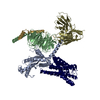 8zd1C 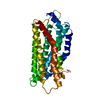 8zf4C 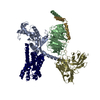 8zf6C 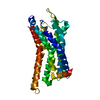 8zf7C 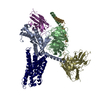 8zf9C 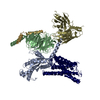 8zfaC  8zfbC 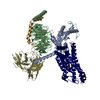 8zfcC 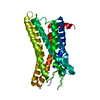 8zfdC  8zfeC 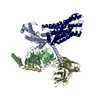 9jvgC 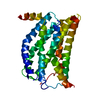 9jvmC M: このデータのモデリングに利用したマップデータ C: 同じ文献を引用 ( |
|---|---|
| 類似構造データ | 類似検索 - 機能・相同性  F&H 検索 F&H 検索 |
- リンク
リンク
- 集合体
集合体
| 登録構造単位 | 
|
|---|---|
| 1 |
|
- 要素
要素
| #1: タンパク質 | 分子量: 41149.789 Da / 分子数: 1 / 由来タイプ: 組換発現 / 由来: (組換発現)  発現宿主:  参照: UniProt: Q8BUD0 |
|---|---|
| Has protein modification | Y |
-実験情報
-実験
| 実験 | 手法: 電子顕微鏡法 |
|---|---|
| EM実験 | 試料の集合状態: PARTICLE / 3次元再構成法: 単粒子再構成法 |
- 試料調製
試料調製
| 構成要素 | 名称: Cryo-EM structure of the mmGPR4-Gs receptor in pH6.2 タイプ: COMPLEX / Entity ID: all / 由来: RECOMBINANT |
|---|---|
| 由来(天然) | 生物種:  |
| 由来(組換発現) | 生物種:  |
| 緩衝液 | pH: 6.2 |
| 試料 | 包埋: NO / シャドウイング: NO / 染色: NO / 凍結: YES |
| 急速凍結 | 凍結剤: ETHANE |
- 電子顕微鏡撮影
電子顕微鏡撮影
| 実験機器 |  モデル: Titan Krios / 画像提供: FEI Company |
|---|---|
| 顕微鏡 | モデル: TFS KRIOS |
| 電子銃 | 電子線源:  FIELD EMISSION GUN / 加速電圧: 300 kV / 照射モード: FLOOD BEAM FIELD EMISSION GUN / 加速電圧: 300 kV / 照射モード: FLOOD BEAM |
| 電子レンズ | モード: DIFFRACTION / 最大 デフォーカス(公称値): 2000 nm / 最小 デフォーカス(公称値): 1000 nm |
| 撮影 | 電子線照射量: 1.875 e/Å2 / フィルム・検出器のモデル: GATAN K3 (6k x 4k) |
- 解析
解析
| EMソフトウェア | 名称: PHENIX / カテゴリ: モデル精密化 | ||||||||||||||||||||||||
|---|---|---|---|---|---|---|---|---|---|---|---|---|---|---|---|---|---|---|---|---|---|---|---|---|---|
| CTF補正 | タイプ: NONE | ||||||||||||||||||||||||
| 3次元再構成 | 解像度: 2.76 Å / 解像度の算出法: FSC 0.143 CUT-OFF / 粒子像の数: 193910 / 対称性のタイプ: POINT | ||||||||||||||||||||||||
| 精密化 | 立体化学のターゲット値: REAL-SPACE (WEIGHTED MAP SUM AT ATOM CENTERS) | ||||||||||||||||||||||||
| 拘束条件 |
|
 ムービー
ムービー コントローラー
コントローラー














 PDBj
PDBj







